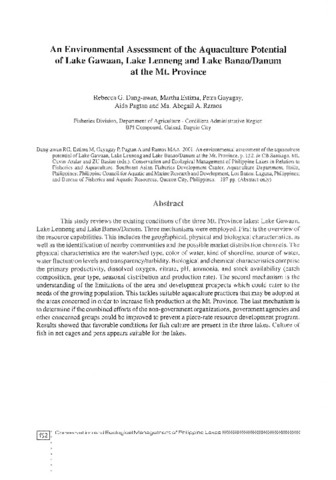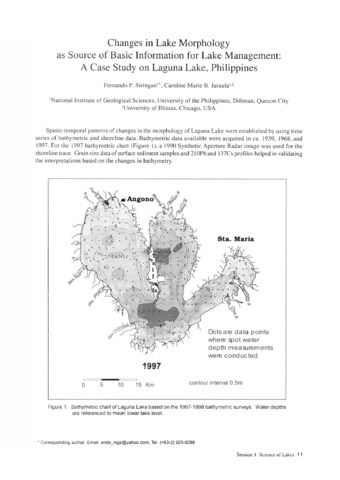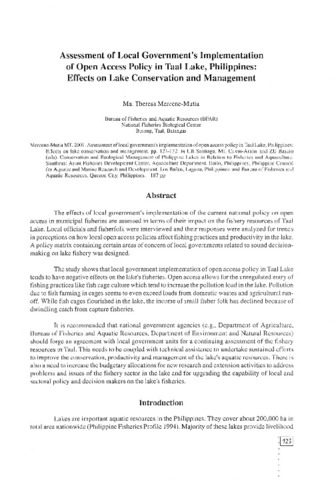Low isozyme variation in native and transplanted populations of the endemic Philippine silver perch, Leiopotherapon plumbeus (Kner, 1864) from three lakes in the Philippines
- Global styles
- MLA
- Vancouver
- Elsevier - Harvard
- APA
- Help

View/
Date
2008Author
Page views
1,668ASFA keyword
Taxonomic term
Geographic names
Metadata
Show full item record
Share
Abstract
The silver perch, Leiopotherapon plumbeus (Kner, 1864), is an endemic and economically important fish in the Philippines. A native species of Laguna de Bay, the silver perch was transplanted from this lake to Sampaloc Lake in the late 1950s and Taal Lake in the early 1970s. Morphological variation has been observed among the native and transplanted populations of the silver perch. In this study, genetic variation within and between the native and transplanted populations was examined using isozyme electrophoresis. Four sites were sampled: two in Laguna de Bay (Binangonan and Tanay) and one each in Sampaloc Lake and Taal Lake. Twenty-two (22) loci were scored but only one locus (PGM*) was polymorphic by the 95% criterion and only two loci (ADH* and PGM*) were polymorphic by the 99% criterion. The average heterozygosities, genetic distances and FST values of specimens from the four sites were very low, suggesting that the native and transplanted populations had very low genetic variation and that they were genetically homogeneous despite the presence of morphological varia- tion. The low genetic variation could possibly be due to a population bottleneck in the native population in Laguna de Bay in the past and to the low genetic variation of the founders in the transplanted populations.
Suggested Citation
Quilang, J. P., Basiao, Z. U., Pagulayan, R. C., Roderos, R. R., & Cao, E. P. (2008). Low isozyme variation in native and transplanted populations of the endemic Philippine silver perch, Leiopotherapon plumbeus (Kner, 1864) from three lakes in the Philippines. Philippine Agricultural Scientist , 91(1), 99-103. http://hdl.handle.net/10862/2084
Type
ArticleISSN
0031-7454Collections
- Journal Articles [1258]
Related items
Showing items related by title, author, creator and subject.
-
An environmental assessment of the aquaculture potential of Lake Gawaan, Lake Lenneng and Lake Banao/Danum at the Mt. Province
Dang-awan, Rebecca G.; Estima, Martha; Gayagay, Petra; Pagtan, Aida; Ramos, Ma. Abegail A. (Aquaculture Department, Southeast Asian Fisheries Development Center; Philippine Council for Aquatic and Marine Research and Development (PCAMRD), Department of Science and Technology; Bureau of Fisheries and Aquatic Resources, 2001)This study reviews the existing conditions of the three Mt. Province lakes: Lake Gawaan, Lake Lenneng and Lake Banao/Danum. Three mechanisms were employed. First is the overview of the resource capabilities. This includes ... -
Changes in lake morphology as source of basic information for lake management: A case study on Laguna Lake, Philippines
Siringan, Fernando P.; Jaraula, Caroline Marie B. (Southeast Asian Regional Center for Graduate Study and Research in Agriculture (SEARCA), 2005) -
Assessment of local government's implementation of open access policy in Taal Lake, Philippines: Effects on lake conservation and management
Mercene-Mutia, Ma. Theresa (Aquaculture Department, Southeast Asian Fisheries Development Center; Philippine Council for Aquatic and Marine Research and Development (PCAMRD), Department of Science and Technology; Bureau of Fisheries and Aquatic Resources, 2001)The effects of local government's implementation of the current national policy on open access in municipal fisheries are assessed in terms of their impact on the fishery resources of Taal Lake. Local officials and fisherfolk ...






